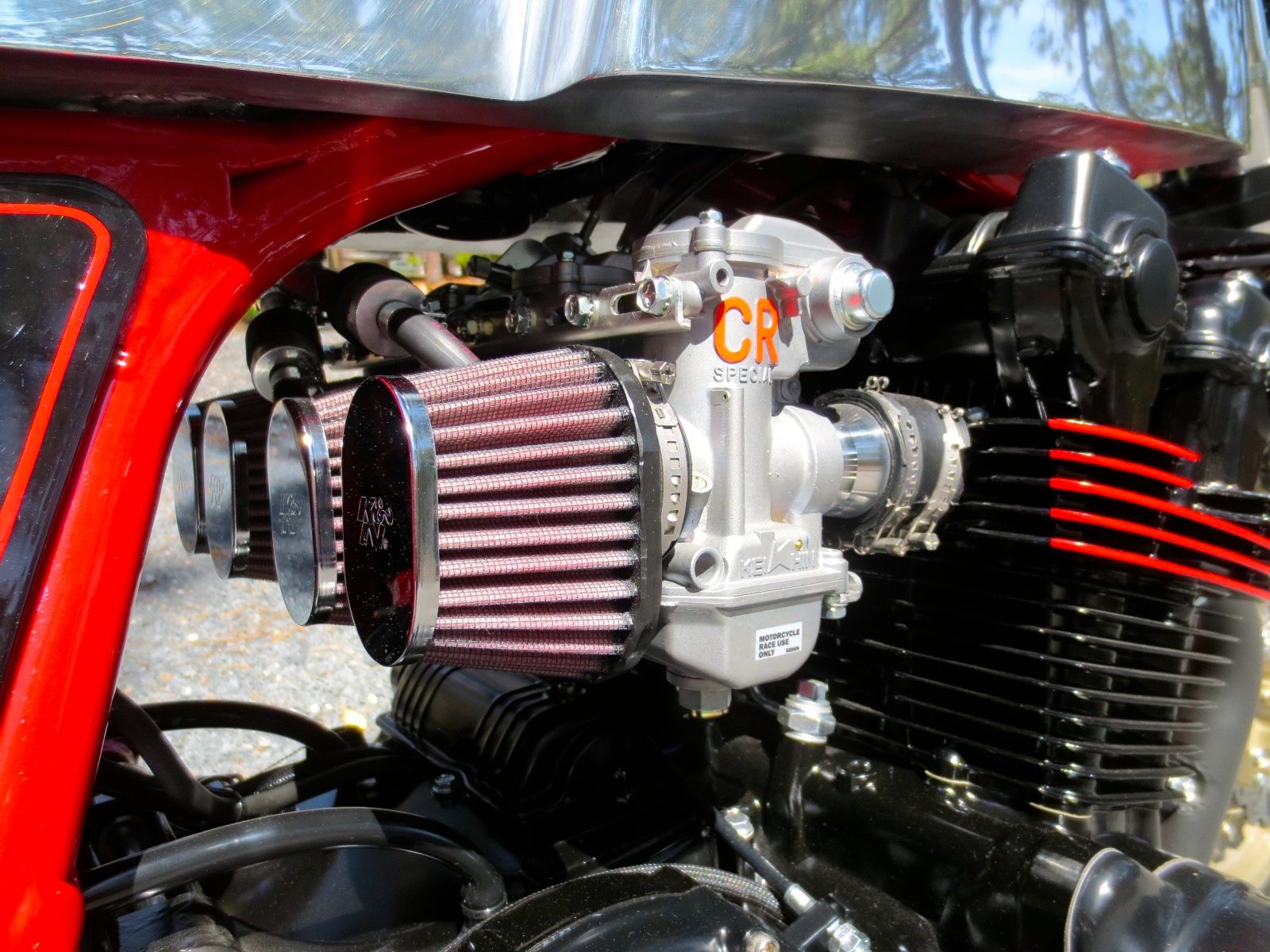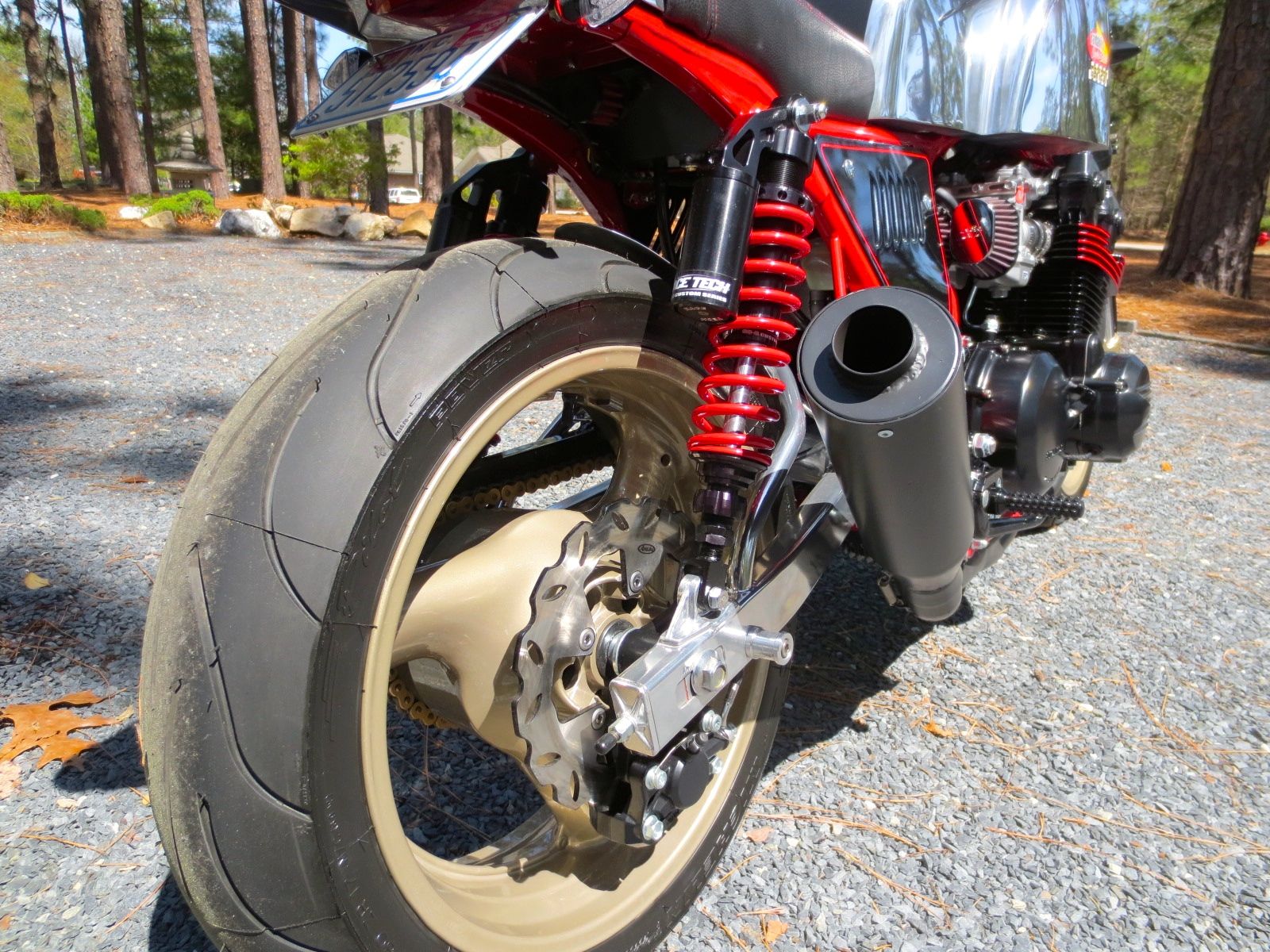“Pod” filters certainly look pretty “racy.” Are they a good option on your bike?
If you have sweet Keihin CR Roundslide carbs like the ones shown above on my CB1123F, then you have race carbs that are designed to facilitate extensive tuning. Non-CV Carbs like these are almost infinitely adjustable via an extensive selection array of jets, needles and other calibration components that are easy to access and swap. Armed with this flexibility, it’s easy to optimize carburetion for any given combination of air filtration and exhaust.
But what if you’re not running carbs like these and you have the stock carbs on your bike? Then, here’s my advice:
OEM Honda constant velocity carbs manufactured by Keihin of this vintage and design are very sensitive to flow dynamics on the intake side. Here I’m referring to all carbureted GoldWings, CBXs, CX500s, DOHC-4s, FT500s, etc.
That’s why departures from the OEM air filter and air-box are not advised in most cases. K&N makes a good product, but I don’t recommend such air filters for bikes running OEM constant velocity carbs. The Honda engineers have already calibrated the carbs for the optimal air flow for max power and efficiency. CV carbs are theoretically “self-adjusting,” but the reality is that they are rather sensitive and their inherent flexibility is easily exceeded.
Ditto for “pod” filters of any brand actually. In fact, poorly constructed or poorly matched “pod” filters can have so much obstruction on the inside diameter (ID) aspect that they can actually block air “bleed” jets located at the mouth of the carbs! That’s an issue you definitely want to avoid!
Adding even more air via a “free-flow” filter does always not help performance. In fact, it can introduce chronic, undesirable leanness which is hard to overcome on carbs that were not designed to be “tuned” to any great extent. The jet and needle choices for the stock Keihin carbs are very limited!
Aftermarket filters typically make lots of “noise,” but noise does not equal power.
I’m not alone on this point of view. Per carb expert Mike Nixon:
“One thing folks seem to not be willing to believe is that changes to the intake side of the engine have 20 times or more the effect that changes to the exhaust side have. Specifically, change the exhaust, no change to carburetion. Change the air filter type however, especially going to pods, and a HUGE change requiring changes to the main jet of over 10 jet sizes! This is likely your problem if you are using pods and the carbs have not be rejetted to them. Fitting the stock airbox and air filter is of course the better solution. 🙂 Mainly because, although the carbs CAN be jetted to match the pods, and the engine will run right, the factory seamless throttle action will suffer, even with the proper jets.”
However, setting aside the dubious merit of more exhaust noise level, these bikes will tolerate almost any exhaust without the need to re-jet so long as the intake is the stock setup.
Keep in mind that the OEM exhausts on Hondas of this vintage are not only quiet, they flow exceptionally well and out-perform virtually all aftermarket pipes.
Again, noise does not equal power!





I wanted to add to this conversation and say what jetting and specs worked for my 1983 cx650C.
The needles were shimmed twice, the pilot jet is a 54, main jet is a 90, secondary main is a132. The fuel screw is at the stock position at 2.25 turns out from lightly seated.
I hope this helps someone who is having trouble finding 650 info.
Thanks Russel, your input is greatly appreciated!
bill mills .. spelling error .. VTR 996 in my post
I have an idea of making 2 into one Y and then bolt on an exauhst tube from my late var 996 just cause im bored . id be interested in the sound and less weight and performance. more importantly, would there be any harm to motor or etc etc..
I think I recall mr Washington speak to this when we met at the Carmel bike show and I believe he said NOTHING could bother these motors by changing puppies like that … but he may NOT have said anything like that either , could’ve been wishful dreaming …
anyhow , thoughts anyone ? experience ?
I have a FT-500. It has an aftermarket pipe, a large K&N, a 160 main jet, 2 flat washers on the needle jet and a 55 pilot jet.
I did the air filter and jetting. The super-tuning resulted in a very notable performance improvement. Maybe it was underperforming when I started but my experience indicates improvements can be achieved with after market performance parts. The bike was so much quicker through the years that I added a time oth to the front sprocket to stretch the gears a little.
None of you have been on a properly tuned FT-500 with aftermarket pipe, a M&E with an extension and I am running a 160 main jet, 2 washers on the needle. Pulls the front wheel in 1st with no clutch. Added front teeth to stretch the gears.
Thanks for your article on stock air filters and exhaust tips. I totally agree with the suggestions. The engineers designed the stock air boxes to be tuned to air flow and power band; only slight alterations to the carbs are required depending on elevation.
After trying many combinations from inaccurate information, I went back to the stock air box and filter and regained Drive ability and better fuel mileage.
With constant velocity carbs, they are very difficult to tune to get the proper air fuel mixture between the pilot, needles and main jets.
You spoke of a gold wing with stock air box and a K&N filter not being too good. But what about an 83 CB1100F with stock exhaust and carbs, stock air box and the K&N filter? I’ve ridden 35,000 miles with this setup. Seems to run ok. But it’s been that way from the beginning. So I have no comparison to using the stock filter. If it is affecting the bike too much, I will go back to the stock paper filter. What’s your advise? Thanks
Basani made pipes for the GL-1000 in the late ‘70s. They were made with the crossover pipe & removable baffles. I would love to have a set again for my ‘78.
Thanks for all your valuable info.
Have a cb650sc, and the carb to air box boots, are out of shape & don’t fit well, going into the air box. I’ve ordered the dynajet jet let & uni foam air filters, next step the Mac four into 1 exhaust, due to rust holes on stock mufflers.
So, if everything was in good workable shape, I’d keep it stock, but have to try to make my bike run better then it does now.
Hi
Thanks for a very useful info source, I was lucky enough to pick up a great condition original paintwork, low mileage ’75 GL1000 and your site is a lifesaver. Further to your post above, you might be interested in this test of K&N’s which suggests that maybe they’re not even a particularly good product http://www.nicoclub.com/archives/kn-vs-oem-filter.html, or at very least have some trade-offs that don’t seem to be worth the limited benefits. I started reading around after I bought K&N’s for a Guzzi, and was horrified to note that the filter elements are so coarse that you can seen the holes with your naked eye. Not something I’d consider risking here in dusty South Africa.
Very interesting article. Thanks for passing that along. Randakk
So, a K&N air filter in the stock airboxon my 1976 Gl1000 LTD is not a good idea?
Thanks for all the good info and repro parts… 🙂
Not a huge issue for GoldWings. The K&N air filter is an excellent product, but I prefer OEM air filters for GoldWings for the reasons stated above. A “high-flow” air filter can introduce a bit of unnecessary leanness.